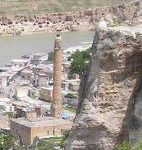Men of all ages, most of them wearing dashing black moustaches and white cotton caps that contrast with their pitch dark eyes and brown skin, pass each other on the narrow lanes of this market, just north of the Pakistani capital Islamabad. Some appear to have no reason to be here, leaning leisurely against graffiti-soaked house walls, waiting for something to catch their interest. Others are hard at work, exposing sweaty muscular torsos as they unload three, four or five wooden boxes filled with yellow mangoes from a truck onto their shoulders. The weight of the boxes challenges their balance – but not a mango is spilled.
Life in this market hasn’t changed for a long time. Trucks bring wheat, spinach, apples, cucumbers, mangoes, herbs and pumpkins from the villages. The produce changes hands quickly; fathers, shopkeepers and restaurant owners carry the food on bicycles, motorbikes and minibuses out of the market and into the city. More food arrives.
Meanwhile, others in Pakistan go hungry and live in the dark. In front of the public bread shops that sell at subsidized rates, women fight over food. In forty thousand villages all over Pakistan, people cannot turn on a light. Less than half the population is connected to the national grid.
Yet, when the media talks about the power vacuum in Pakistan, journalists don’t talk about the 80 million people without access to electricity. When journalists write about the era of possibilities and risks in Pakistan, they are not talking about the risks of not being able to buy bread or improving access to electricity.
The change on everybody’s horizon is the post-Musharraf era. After the resignation of president Musharraf in August, the western media and the elites in Pakistan are debating whether democracy will now finally give in to the historically strong military, or whether the country is at last getting a chance to bloom with a government that can address key issues facing the country, including food security and access to electricity, instead of being deadlocked over the question of whether or not to impeach Musharraf.
Some blame the deadlock over the Musharraf question for the lack of progress on key issues facing Pakistan. Others, including the current government, assert that the former government blatantly neglected important investments that could have sustained and distributed economic growth.
The lack of investment in power generation is often mentioned as a prime example of the government’s serious inattention to securing a lasting base for growth and development. Some 35 years have passed since the last large dam, Tarbela, was built on the Indus River in Pakistan. Tarbela had a proposed hydropower generation capacity of 2,100 megawatts, which was later upgraded to 3,400 megawatts, in addition to water storage and irrigation. At the time of construction, Tarbela was the largest earth-fill dam in the world.
In some circles there is a perception that since Tarbela, hydropower development has been neglected and that is the reason the country suffers from power shortages. Yet the nation has in fact had a surge in hydropower development, and hydro now accounts for a third of the nation’s electricity production. Tarbela was upgraded to increase its hydropower capacity by a third in the early 1990s; the Chashma hydropower project commenced operating in 2001; Ghazi Barotha, a hydropower project just seven kilometres downstream from the Tarbela dam, commenced energy generation in 2002; and Pakistan’s Water and Power Development Authority is now working to raise the Mangla dam in order to increase its storage and energy generation capacity.
However, even though hydropower capacity has been added to the national grid in Pakistan in recent years, it is not enough – in part because the transmission system has continued to languish, and up to one-third of all electricity that passes through its lines is "unaccounted for" (either stolen or wasted though the poorly maintained system). In response, people have adopted what they call "the privatisation of the energy sector": every business, every office and every household that can afford it has their own private diesel generator in the backyard. And still, millions of households cannot turn on a light in the evening.
With economic growth rates between 6% to 8% in recent years, the energy needs of the country are growing more rapidly than new energy generation capacity. Pakistan is consuming all of its domestically produced natural gas, and is making plans to construct a pipeline to import gas from Iran. Domestic oil resources are not sufficient to meet the needs of the country and imports of oil as well as refined petroleum products from the Middle East are steadily growing. Thermal power plants generate roughly two-thirds of the country’s electricity.
With daily blackouts disturbing commercial life in the cities and the majority of the rural population without access to the national grid or other modern energy sources, demands to build more power plants are getting louder every month. The uncertainty over whether demand already outstrips supply, or whether a better management of the energy sector would actually solve the problem, is being pushed aside. Former governments are being accused of neglect and current governments are being pressed to present quick, grand solutions.
One of these is the Diamer-Bhasha Dam on the Indus in northern Pakistan. This project would have an installed capacity of 4,500 megawatts, with a price tag of over US$8.5 billion, indeed a big proposal. The 200 square kilometre reservoir would flood 100 kilometres of the Karakoram highway, villages that house over 35,000 people would disappear, and up to 50,000 thousand-year old rock carvings would vanish.
The dam would be constructed near Chilas, on the border of the North Western Frontier Province and Northern Areas. The reservoir would be in the politically contested Northern Areas, referred to by India as Pakistan-occupied Kashmir. The region also presents engineering challenges due to its difficult topography. One challenge will be widening the Karakorum highway, along which all material for the dam would have to be transported. It is unclear where the high-voltage transmission lines for the dam’s electricity would be installed as the mountains next to the highway are too steep.
The World Bank, which initially appeared to have an interest in the project and is historically the major funder of large dams in Pakistan, has declined to fund Diamer-Bhasha because of its location in a territory claimed by both India and Pakistan. In August 2008, media reports in Pakistan suggested that China would pay the bill. Not only pay the bill, but send thousands of workers from its Three Gorges
Dam site to Pakistan to construct, if not a replica of Three Gorges, then at least the largest hydropower project ever built on Pakistani soil. The reports on China’s involvement have not been substantiated, but the chairman of Pakistan’s national Water and Power Development Authority (WAPDA) is hopeful: "The construction of the main water reservoir (dam) of the Bhasha project will be initiated by the middle of the next year and everything will be in place by that time," Shakeel Durrani told The News, the leading English-language newspaper in Pakistan in August 2008.
Others are more cautious. Observers familiar with the project design invoke the engineering challenges and huge financial costs associated with rebuilding bridges, constructing high-voltage transmission lines and relocating 100 kilometres of the Karakorum highway to a higher elevation, in this mountainous, earthquake-prone area. Others question whether one can justify the construction of a dam that would destroy thousands of rock carvings that testify to the great cultures that have inhabited and travelled the Indus valley.
The earliest examples of the rock carvings on both sides of the Indus near Chilas date back to prehistoric times; the most recent ones testify the Islamisation of the region in the 14th century. Many of the carvings were done by merchants and pilgrims who travelled the paths along the Indus valley that constituted branches of the Silk Road.
Professor Harald Hauptmann, the leading archaeologist of the region, says that the greatest part of the rock art galleries would be destroyed as a result of the construction of the dam. "Forget everything. More than 80% will be submerged and the remaining rock carvings on the slopes will be destroyed because of the construction of the new 100-kilometre stretch of Karakorum Highway."
In Islamabad, however, the Northern Areas, its inhabitants and the rock carvings on the banks of the Indus are far away. More pressing are the daily power outages and the misery of load shedding. Drowning out calls for the galleries’ preservation are loud demands for new power projects and for the government to make decisions. Even though the Diamer-Bhasha Dam will take at least eight years to build and will cost US$8.5 billion, it’s a concrete way for the government to demonstrate action. Yet it is not a project that will increase access to electricity in rural Pakistan. The houses in 40,000 Pakistani villages without access to electricity will not suddenly light up after the construction of the Diamer-Bhasha Dam. Decentralized energy options, such as small-scale wind turbines, solar systems and micro-hydropower for those not connected to the national grid are neglected at the expense of mega-projects that hold many promises, and are beset with many risks.
The lives of the men in the market north of Islamabad, the lives of the women queuing up in front of the public bread shops and the lives of the people in the 40,000 villages in Pakistan will not change with the decision to construct the Diamer-Bhasha Dam. If the government decides to build the dam, the electricity supply in Islamabad and other big towns might be more steady – albeit, in ten years time, and only if climate change doesn’t reduce the region’s river flows. If the government decides to construct the dam, 50,000 rock carvings will be destroyed. If the government decided to implement energy efficiency measures, industrial power use could rapidly be cut by a quarter. But for now, the calls for Pakistan’s largest hydropower project drown out the more silent and cautious calls for energy efficiency measures and small-scale renewable energy projects.
Ann-Kathrin Schneider is South Asia programme director and policy analyst at International Rivers. Ms. Schneider holds a Master’s degree in Development Studies from the School of Oriental and African Studies in London. Her work focuses on monitoring and challenging the activities of international financial institutions such as the World Bank and private banks.
This article first appeared on the website of the Heinrich Boell Foundation. It was also published on the International Rivers website.




